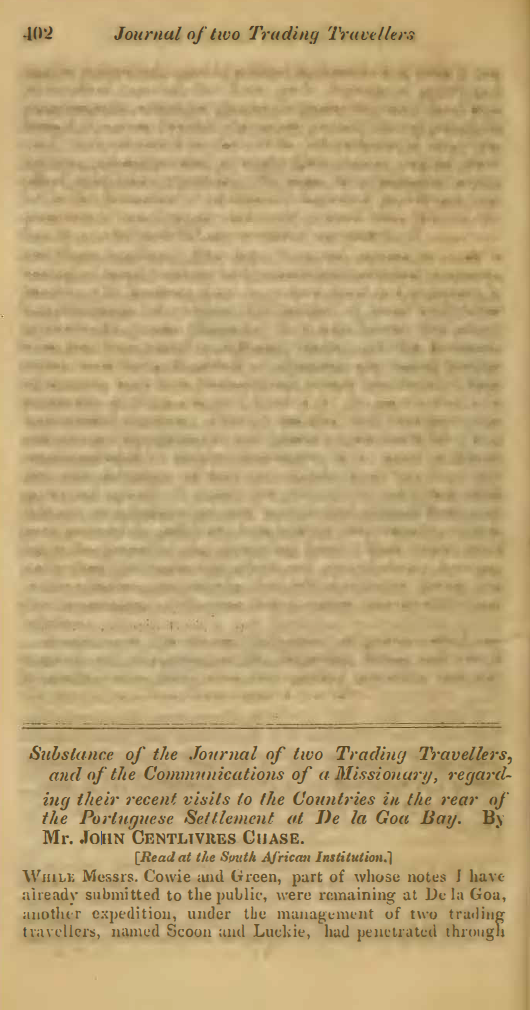Substance of the journal of two trading travellers, and of the communications of a missionary, regarding their recent visits to the countries in the rear of the Portuguese Settlement ot De la Goa Bay
DOI:
https://doi.org/10.21504/saqj.14.2663Keywords:
Expeditions -- Southern Africa, De la Goa Bay, Sichuana (Tswana), Bichuana, Griqua, Zulus, Mantatotes, Malacatzie, Moriqua River, Missionaries, Rev. Mr. ArchbellAbstract
This paper presents extracts from the journal of two trading travellers, Scoon and Luckie, detailing their 1829 expedition from the Griqua country (Campbell's Dorp) through the Sichuana (Bichuana) territory towards the interior regions in the rear of De la Goa Bay.
I. Route and Geography-
The journey began at Campbell's Dorp (June 16, 1829) and proceeded generally N.E., crossing the Hart River and passing various fountains (Daniel's Kuyl, Bootschap, Kriegar's, Patti).
-
The route traversed large, red, sandy flats and eventually reached improving country with fine pasturage and mimosa forests.
-
The explorers crossed several rivers, including the Mala Moloppo (separating the Morolong and Morutze tribes) and the Moriqua River.
-
The Moriqua River is described as rapid, clear, and about 40 feet wide, running N. by N.E. before entering a high ridge of mountains (running E. and W.), which the natives say leads to the sea. The travellers traced it for 150 miles.
-
The terrain becomes mountainous (general range E. and W.) near the Morutzi town of Hammasiclia.
-
The expedition passed through Morolong and Morutze territory, meeting Batlokwa Bichuanas and Corannas.
-
The travellers visited a deserted Kurreechane (Chuan) and a new town (c. 2000 inhabitants) where they were admitted to copper and iron mines. The iron ore was so rich it required only three beatings to form into bars.
-
They were met by messengers from Malacatzie, a Zulo/Mantatote captain (brother to the late Chaka), who extended a strong invitation and offered oxen.
-
They encountered extraordinary living arrangements, including 17 conical huts built in the branches of a single tree (likely a mimosa) for shelter from the numerous lions.
-
The travellers reached Malacatzie's main kraal (c. 3,000 head of cattle) and conducted a highly profitable trade, valued at nearly £1800 sterling.
-
Malacatzie ruled over about 80,000 people (Zoolah in language, dress, and arms), having conquered the land from the Batswana tribes 12 years prior. He was tyrannical and desired trade and arms/ammunition to resist his enemy, Dingaan (Chaka's successor).
-
Upon the chief's request, Rev. Mr Archbell of Platteberg immediately visited, tracing one of the main branches of the Gariep (Orange) River to its source via a new route.
-
The country is noted for its fertility, abundant water, ten species of vines, and a plentiful population of elephants.
The author concludes that the friendly disposition of the natives, the healthy climate, fertility, and available barter property offer significant advantages for future trade and exploration, promising important discoveries in this previously unknown region of Southern Africa.
Downloads

